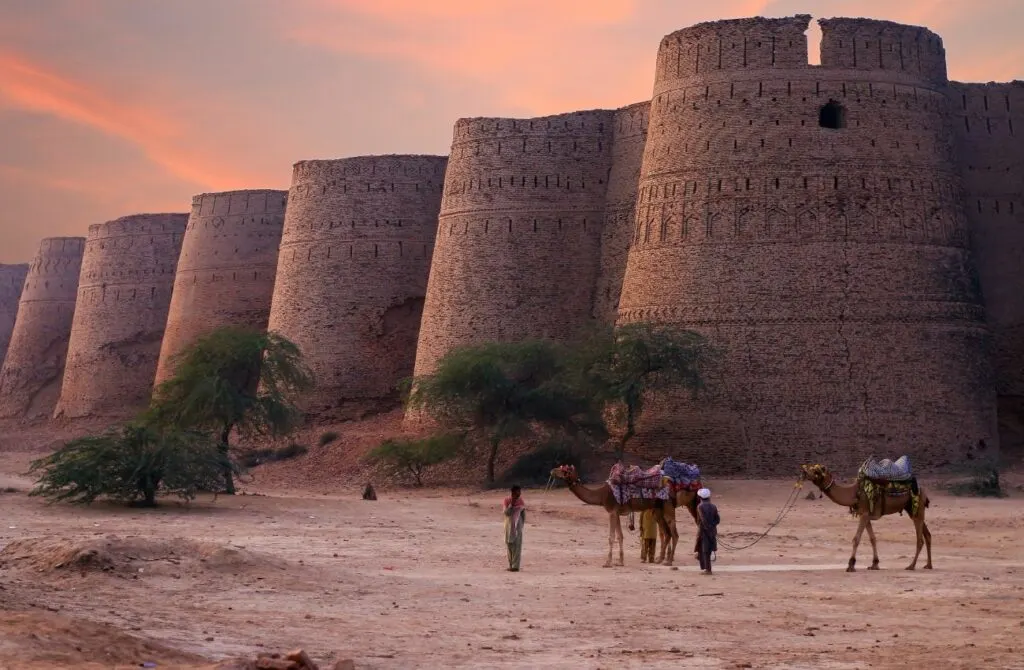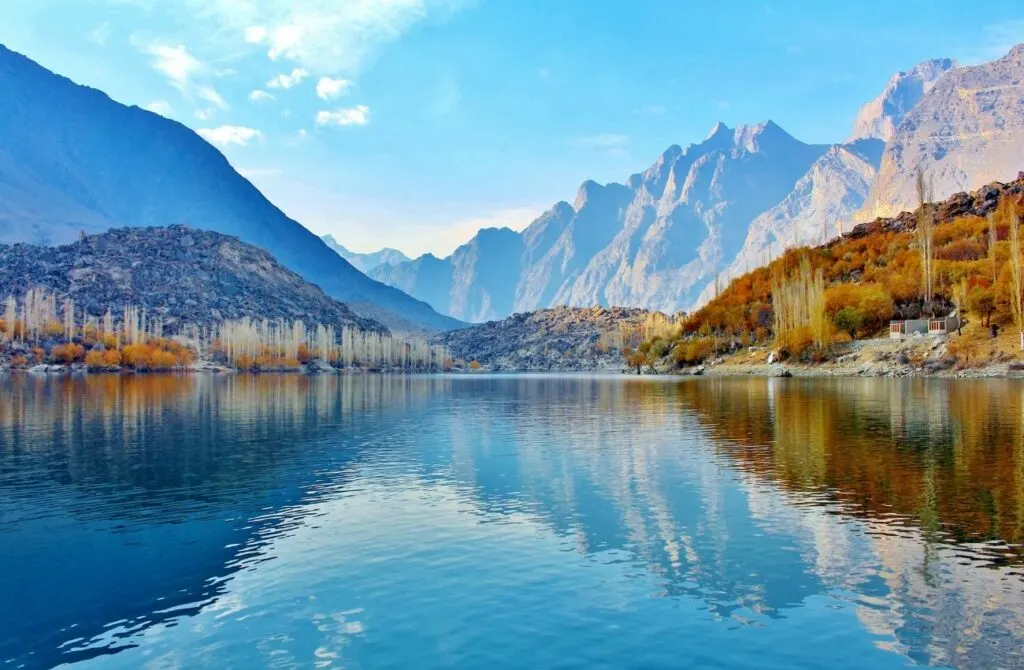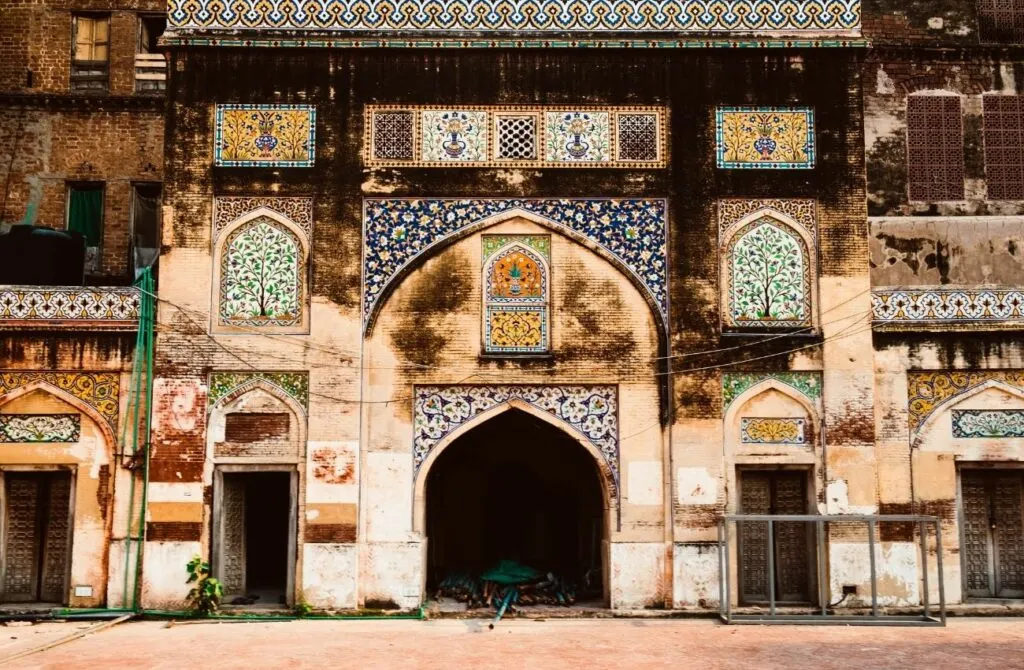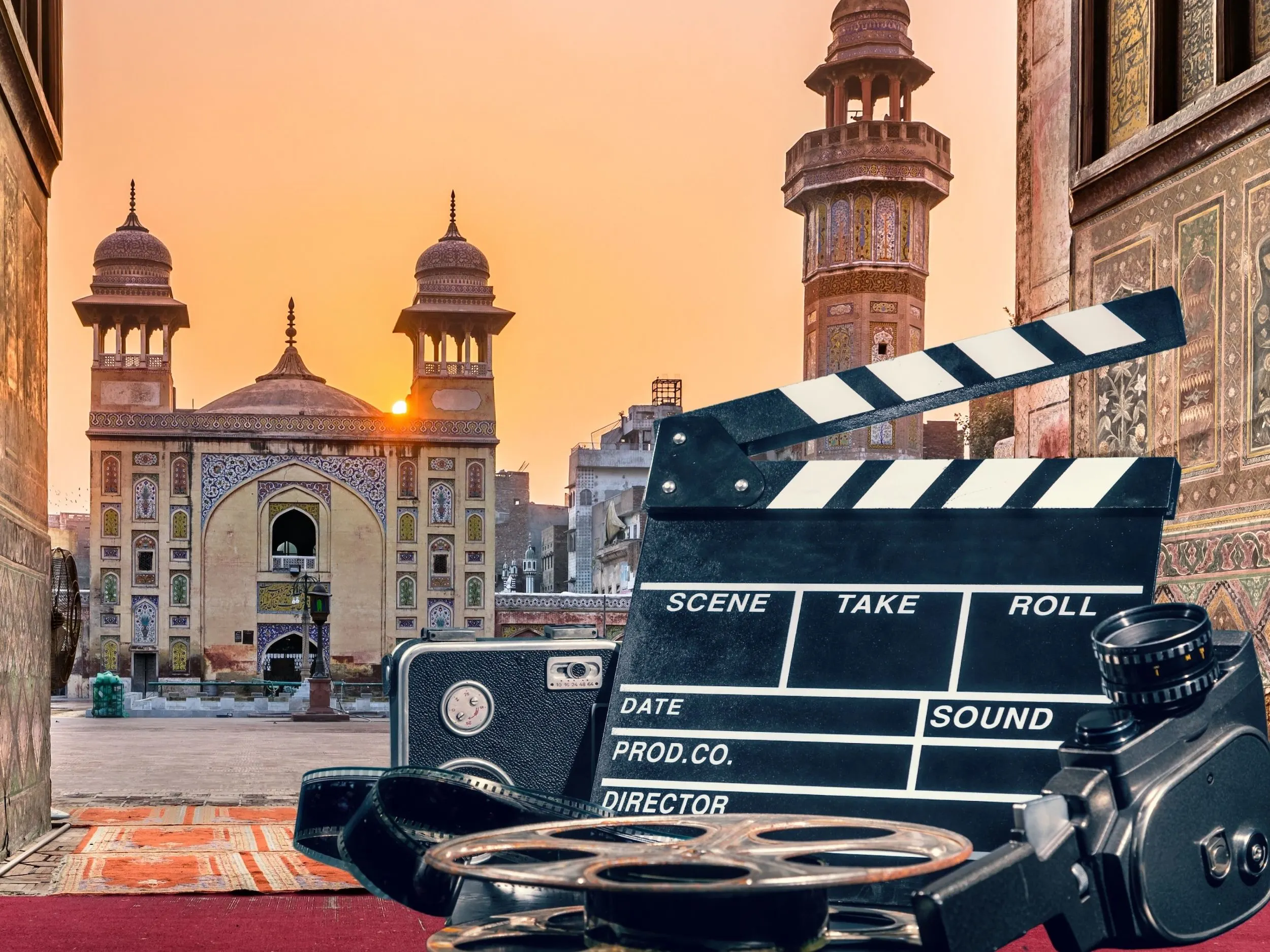Sofia De Vera combines a heartfelt passion for cinema with over 15 years of critiquing for esteemed film publications, wielding academic credentials from the University of Southern California and New York University, to serve as your personal guide through the enchanting worlds of film and television. Her full guest bio can be found here.
Pakistan has a lot to offer both national and international filmmakers with exquisite natural wonders, intriguing urban landscapes, and a rich cultural heritage. So it will come as no surprise that there are so many wonderful movies set in Pakistan.
Watching a good movie is the best way to get inspired and choose your next destination. It is the reason we have assembled various lists of the best films shot in some of our all-time favorite travel destinations: Turkey, Afghanistan, Oregon, South Africa, Thailand, Barcelona and Dubai.
There are things that a photo alone can’t capture. We are human, and we need movement: the waves crashing against a sandy beach, the sun setting against the savannah horizon, and people walking side by side through an imposing urban environment. These are things that are better experienced with movement. These are things that belong in movies. And these things are Pakistan.

Pakistan is actually one of the top 20 film-producing countries in the world, making 60 feature films each year. Pakistan possessed three major film production hubs till 1971: Lahore, Karachi, and Dhaka. The largest is Lollywood, which is situated in Lahore.
The bulk of Pakistani films is produced in Urdu, although many are also produced in English, Punjabi, Pashto, Balochi, and Sindhi, reflecting the country’s multiculturalism. Although being dominated by Bollywood, poor screenwriting, restrictions, a lack of technologies, and screen failures, the Pakistani cinema and drama business has seen significant development in the twenty-first century. Notwithstanding these flaws, young Pakistani actors have not only altered the film business through their on-screen performances; they have also impacted how Pakistani society sees the country’s problems.
The following list of movies set in Pakistan, which includes six local Pakistani films, four Pakistani films available exclusively on Netflix, two Bollywood films with Pakistan as a setting, and two Hollywood films with Pakistan as a setting, will paint a picture of a complex country filled with gorgeous sights and diverse voices – while also entertaining you. With this, we hope to help audiences step into the often-contradictory world of Pakistan and experience the scenery, subcultures, and different dynamics that make Pakistan what it is today.
These Pakistani films frequently boast narratives that rely on their settings as much as their main protagonists, and as a result, spectators get a glimpse of Pakistan through the director’s eyes. Be forewarned that not all of these films are happy – tragedies and misery are as unavoidable in cinema as they are in life – be we promise that each one provides panoramic vistas and thought-provoking narratives from this tantalizing country…
Wondering where to watch? It depends on where you live in the world and which streaming services you have. We link to the streaming service we watch on in each case - be it Netflix, Amazon Prime, Apple TV+, or elsewhere.
You can get one month free of Amazon Prime (or a 6-month trial for students) of Amazon Prime and also get immediate access to FREE Two Day shipping, Amazon Video, and Music. While you won't be charged for your free trial, you'll be upgraded to a paid membership plan automatically at the end of the trial period - though if you have already binged all these, you could just cancel before the trial ends.
Apple TV+ also has a one-week trial, and Hulu has a one-month trial (which can be bundled with Disney!). Another option might be using a VPN to access Netflix titles locked to other regions. Netflix is now available in more than 190 countries worldwide and each country has a different library and availability. US Netflix is (understandably) one of the best.
While we wish everything could just be in one place - for now, it seems these are the best streaming platforms to watch on.



Page Contents
- Khuda Keliye / In The Name Of God (2007)
- Bol / Speak Up (2007)
- Laal Kabootar / Red Pigeon (2019)
- Pinky Memsaab / Pinky Madam (2018)
- Manto (2015)
- Mah e Mir / Month Of Mir (2016)
- Dukhtar / Daughter (2014)
- Zindagi Kitnihasseen Hay / Life Is So Beautiful (2017)
- Ho Mann Jahan / Be Where Your Heart Is (2016)
- Allahyar And The Legend Of Markhor (2018)
- Veer Zaara (2004)
- Bajrangi Bhaijaan / Bajrangi Brother (2015)
- Rambo 3 (1988)
- A Mighty Heart (2007)
Khuda Keliye / In The Name Of God (2007)
The storyline follows two families, one from the United Kingdom and the other from Pakistan. The father of a British household forcefully sends his daughter Mariyam (Iman Ali) to Pakistan to marry a Pakistani Muslim lad.
Sarmad (Fawad Khan), the younger brother of two singing brothers, gets smitten by Maulana Tahiri (Rasheed Naz) and joins the fundamentalist cause, marrying a British lady in a hamlet near Afghanistan. Mansoor (Shan), the older brother, travels to the United States and is apprehended by US authorities as a potential terrorist; he is tormented and expelled back to Pakistan. To send the girl back to the United Kingdom, a court case and a right reading of the Quran by Maulana Wali (Naseeruddin Shah) are required. Finally, the girl establishes a school in the area, and the siblings reconcile with their parents.
The connections in Khuda Keliye / In The Name Of God highlighted between both the Chicago racial profiling incident and everything else going on in Pakistan were remarkable. In regards to their unwavering approach toward whatsoever, they think to be the reality, there are areas where US law enforcement authorities and Jihadi leaders may be interchanged. How they all use euphemisms to get people to say what they want to hear.
The comparisons are also highlighted straight toward the conclusion, ensuring that the spectator does not miss them.
Bol / Speak Up (2007)
“Jab khilanahisaktay, to paidakiukartay ho?” (Why did you bring us into the world if you can’t feed us?) The film begins with the spectator meeting a little girl who is ready to be hung. Zainub Khan, played by Humaima Malick, is a little girl.
She is one of Pakistan’s most strong female characters in the industry’s history. She tells the narrative of her family and her battle with her father. This is the tale of a poor family who is unfortunate enough to have a large number of daughters and one transgender child. The cleric pleads Lord for a male to alleviate the financial load, but after six girls, God plays a cruel joke on him by delivering him a transgender son.
Bol / Speak Up tackles a number of sensitive issues, including transphobia, religious fundamentalism, and patriarchy. The family must deal with the problems of polygamy and the father’s male domination. In Zainub, his stereotyped ideas on religion and society had sparked a revolt. These viewpoints are tearing the family apart.
The film depicts patriarchal fixation with a male heir, gender discrimination, conservatism, unemployment, women’s empowerment, bureaucratic obstacles, and a variety of other real-life themes. Bol is, without a doubt, one of the greatest drama films ever made in the Pakistani film industry.
Laal Kabootar / Red Pigeon (2019)
Aliya Malik and Adeel Anwar, two individuals from very diverse sources, are brought together by destiny to fight the same struggle, albeit for very different reasons. The first is wanting revenge or punishment for the assassination of her reporter spouse, while the latter, a cab driver, is attempting to flee the country to his dream destination of Dubai.
Chaos reigns in Karachi’s shadowy underworld, where ambitious real estate developers would go to any length to acquire land. The cops are stupid, apathetic, hesitant to act, corrupt, and frequently complicit. The nexus works well until Ibrahim, the lead detective, suffers a personal setback when his fair and beloved daughter is killed in a gunfight, and collaborates with others to eradicate the singular root of all wrongdoing.
Laal Kabootar is perhaps the sole Pakistani film that stays loyal to its roots, with an accurate depiction of Karachi in its darkest days. And, as far as the plot goes, the first cascade falls with the assassination of a well-known reporter in broad daylight. The lives of an Uber driver (dreaming of traveling to Dubai), a newly widowed woman, a dishonest cop, and a shady businessman are intertwined in Laal Kabootar. It’s a tale of betrayal, dreams, rage, love, and responsibility.
Pinky Memsaab / Pinky Madam (2018)
We, the metropolitan civil elite, burden our life by placing high demands on our family and friends. We harm ourselves and those around us in the process. Pinky arrives in Dubai to work as a housemaid in a home that is experiencing a domestic crisis.
This did not have to be the case. Mehr, a cosmopolitan, uses her rustic upbringing and lack of education to experiment on her in order to make her more acceptable. When Mehr suspects her of having an affair with her husband Hasan, the matter becomes messy, and the couple splits up. There’s a scene when Mehr’s father tells her to maintain writing as a pastime rather than with the hope of becoming published, something I felt was straightforward but thoughtful.
Pinky Memsaab is amusing, humorous, and emotive, but above all, it is unique. The intricacies of the connections shown in the film are difficult not to connect to. Pinky Memsaab has a great point in that it portrays the disparity between the lifestyles of the affluent and poor, as well as the disparity among their sufferings.
Manto (2015)
“Who is the greatest writer God or he?” The tombstone of Manto, one of the finest collections of short stories authors, bears the lines above. Manto isn’t a movie in the conventional sense. It’s an artistic expression of love, gratitude, and respect from one creator (Sarmad) to another (Manto).
In many aspects, Manto is a first: life illustration, characterization, emotional representation of an age, cutting, backdrop soundtrack, and Manto’s ethos coupled with the pangs of division, migration, and societal dis-array have indeed been presented in a way that modern cinema has never seen before.
Sarmad effectively conveys sadness to the audience, who are unaware that their thoughts have transformed into souls and that they have been fed a masterpiece. The sequence in which Manto’s wife smokes a cigarette for him builds to a portrayal by Sarmad that may be likened to any great cinema performance.
Pakistani film, which is rich in experiments and resources, has yet to produce such a tremendous masterpiece. Sarmad and his colleagues have provided us with a concept and presentation that is creative.
Mah e Mir / Month Of Mir (2016)
Mah-e-Mir, which has been chosen to represent Pakistan in the 89th Academy Awards’ foreign-language film classification, has a noble goal of bringing one of Urdu poetry’s most adored figures to the big screen.
Filmmaker Anjum Shahzad illustrates the role of the painter who deigns to stand up to the powers-that-be — whether a grizzled modern news article publisher or a mogul draped in pearls and silk, issuing orders from a cushioned throne — by shifting between scenes of present-day urban Pakistan and its 18th-century royal court.
The film explores a variety of literary topics and features some visually stunning passages that will keep you intrigued. Mah e Mir, on the other hand, isn’t ideal. While the sights are gorgeous and compelling, the film is extremely literary (with its overuse of literary words), making it difficult to watch for the ordinary viewer.
The acting is excellent, but the dancing is lacking in grit. If you enjoy the Vernacular or literature, you might be disappointed that you didn’t have seen this movie.
Dukhtar / Daughter (2014)
Movies such as “Come to My Voice” (Turkey, 2014) and “In Bloom” (Georgia, 2013) excelled as engrossing tales by transcending this paradigm. Dukhtar, a Pakistani film released in 2014, on the other hand, is constantly crippled by its clichés finds it difficult to conform to something unique or interesting.
As a result, you may have already seen this narrative. Every few years, a picture like “Dukhtar” made its way into theatres, generally after a festival run. These films are set in conflict-ridden areas, maybe ripped apart through war or extremism. When Allah Rakhi hears of the clan bargain, she is outraged, especially because she was forced into marriage with Daulat Khan, a much elderly gentleman, when she was just an adolescent. She chooses to depart with her daughter after considering all of the options. Fortunately, they are granted a ride by a widower and lonely man named Sohail, a truck driver.
Allah Rakhi is desperate to meet her mother, whom she hasn’t seen in years. After years of living in a rigid and authoritarian neighborhood, her departure is primarily to preserve her inquisitive and bright daughter, but it is also a passport to a new life of freedom and adventure for her. This film examines the ongoing mother-daughter relationship.
Zindagi Kitnihasseen Hay / Life Is So Beautiful (2017)
Zindagi Kitnihasseen Hay / Life Is So Beautiful makes you think about connections and the value of everyone who is a part of them. Sajal Ali and Feroz Khan are a sophisticated married couple whose egos prohibit them from lovingly raising their gorgeous kid, Dodo.
This skewed relationship is the central theme of the film. Zindagi Kitni Haseen Hay’s main point might be that life is lovely despite its flaws. Break-ups, poverty, and ruined hopes are all depicted in the film, which is a compilation of all the horrible things that may happen in adult life. Dodo seeks to reunite his parents throughout the film. Their family gets their happy ending when he succeeds in persuading them to see the world through his perspective.
Also, while the film raises several important concerns, such as the advantages of living as a family, the popular game that has led to lifeless morning shows on television, and the dangers of living beyond one’s means, all of these topics might have been addressed more gently. The discussions are occasionally enthralling, but only on rare occasions.
Ho Mann Jahan / Be Where Your Heart Is (2016)
This movie is a contemporary urban coming-of-age narrative set in Karachi. Arhan, Manizeh, and Nadir are the three major actors in the film. The plot revolves around their connection, which grew out of shared experiences, a love of music, and a desire to be famous.
Sabina, a powerful autonomous figure signifying strength and wisdom, is played by Sonya Jehan. The film depicts the battle between those who want to express their free choice but are also drawn to conformity. Since they love their kids but don’t always comprehend them, parents place limits and dictate rules.
For me, the theme of the movie would be “go and grab it.” Ho Mann Jahaan isn’t a film about music, and it’s also not about artists. It’s a film about discovering your real calling in which singers are used as an add-on rather than the main course. However, it pulls as many similarities with the Pakistani music business as the number of soda cans that appear in it, which is both perplexing and demeaning to the entertainment industry.
“Our society is so restrictive,” musician Faraz Anwar once commented, “that musicians probably pick up instruments since the neighbors next door have difficulties with the sound.” None of these facts of being a musician in Pakistan are mentioned in the film.
Allahyar And The Legend Of Markhor (2018)
Allahyar & The Legend of Markhor might well be Pakistan’s third animation picture, but it attracts a large audience since it features animals communicating with people in Urdu.
Remember the old days when The Lion King and other foreign films captivated our attention; now, we can see animated films with local themes that address our issues in the most ‘Pakistani’ way imaginable. The grandeur of Pakistan’s northern side that they displayed was really hypnotic; the sights, sceneries, and greenery in the terrain were stunning; I just loved it.
Several components of the film have been well-established and fine-tuned, while others required more work. To make the animated human beings more authentic and lifelike, I feel they should have employed reality synthesizer technology. Characters need to be fine-tuned and developed further. Ultimately, Allahyar, like its predecessor, employs a 3D animation technique that is more adapted to emulation than story, with characters that lack the expressiveness of their western counterparts.
While the animators do an excellent job with the film’s environment, meticulously depicting the mountains and trees, there are certain elements lacking in close-range shots that detract from the overall effect. This might be due to a lack of expertise in producing animated films as well as a scarcity of conventional 2D animators in Pakistan.
Veer Zaara (2004)
Veer Zaara is a sophisticated love tale with people who shine out far more than sumptuous surroundings [unlike some of the other Bollywood movies], and it tells a unique story. When you think the plot is about to become predictable, a twist occurs, and everything flips.
Veer Zaara tells the story of Saamiya Siddiqui (Rani Mukerji), a young female human rights lawyer who is desperate to release Veer Pratap Singh, an Indian prisoner who has been mute and nameless for 22 years. Saamiya recognizes Veer’s identity; this prompts him to speak: When he meets Zaara, a Pakistani girl who enters the country alone to fulfill her Indian mum’s final request to have her ashes returned to her birthplace, his life as an Indian air force rescue pilot changes significantly.
Veer falls in love with Zaara the instant he saves her from a bus accident and forces her to visit his family’s hamlet for the Lodi celebration. Veer’s uncle begs him to court her while she boards a train home after a night of dancing and celebration. Veer, on the other hand, loses his cool when her fiancé greets her at the station.
Zaara is eager to fulfill her family’s expectations and form a political alliance through her marriage, but she can’t get Veer out of her mind as she prepares for the wedding. Zaara’s maid Shabbo phones Veer and ask him to go to Pakistan after witnessing her suffering. He does not delay; consequences be damned.
Bajrangi Bhaijaan / Bajrangi Brother (2015)
A little Pakistani mute girl gets lost in India and has no method of getting back. The mission of returning her to her country and reuniting her with her family is taken on by a dedicated man with a noble soul. The film ‘Bajrangi Bhaijaan’ is a touching story of love and harmony.
Though primarily a delicate father-daughter narrative, the film also serves as an insightful reflection on the ongoing India-Pakistan conflict. The storyline gracefully accommodates comedy, intense emotions, and devastating drama.
Since films are supposed to provoke, Bajrangi Bhaijaan succeeds in this purpose admirably. This will inspire you to connect with virtue. It will persuade you to let go of even the tiniest bit of negativity in your life and to always be optimistic. There’s a golden heart in this one. It’s unlike any other film in which Salman Khan has appeared.
This is a narrative that transcends cultural, geographical and even emotional boundaries. It promises you fantastical fiction set in a perfect world. And no matter how much rationality you use to fight it, it will draw you in and pull at your strings in the background. And love is the only feeling you’ll be able to return.
Rambo 3 (1988)
John Rambo was observed traveling through the city’s market in search of Mousa Ghani’s weapons shop. He saw a number of tribal individuals dressed in ethnic garb, some of whom were armed with or selling ancient German and British firearms.
A few people have been observed with authentic AK-47s. Guns, cloth, food, collectibles, and a variety of other products are among the most commonly sold commodities. It was important to the storyline of Rambo III since it allowed him to meet Mousa Ghanid, who put him in contact with the Mujahaideen and allowed him to save Colonel Sam Trautman, but it also led to his being ratted on by Mousa’s shop assistant, resulting in Rambo being gravely hurt.
A Mighty Heart (2007)
A Mighty Heart isn’t an easy film to watch, but it gives a genuine, often horrific glimpse into the days leading up to Pearl’s capture and execution for those anxious to locate him. In the process, it pays respect to Danny’s inspiring life and his heroic wife.
“A Mighty Heart” opens with pictures of the thronging streets of Karachi, Pakistan, a metropolis where people appear to be crammed shoulder to shoulder. Terrorists will arise from this sea of humanity, grab Daniel Pearl, an American journalist, and then vanish. The movie follows the frantic hunt for Pearl (Dan Futterman) before the shocking footage of his beheading is released.
It is mostly recounted through the eyes of his widow, Mariane, and is based on a memoir by her.


